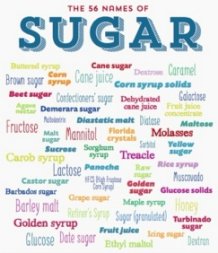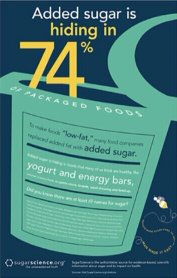We know when we use sugar in tea, coffee, or baking at home. But how much sugar was added to foods and drinks we buy from supermarkets, or order at a restaurant?
Sugar
Although sugars come in many different guises, ‘sugar’ often refers to a simple carbohydrate called sucrose, aka table sugar.
Sucrose is two sugars joined together. Each sucrose molecule is actually one molecule of glucose joined to one molecule of fructose.
The composition of sucrose is important to know, because our bodies use glucose and fructose in very different ways.
To illustrate the important differences in how the two sugars are used, it’s interesting to look at how bears prepare for their winter hibernation.
Fructose
Glucose is sweet, but fructose is far, far sweeter.
Fructose is what gives fruits their sweet taste, which animals and humans like very much. Try eating only one sweet grape from a bunch – it’s almost impossible to resist the inner voice encouraging you: ‘Mmmm! Lovely and sweet. Enjoy a few more!‘.
The inner voice, as I called it, is an ancient evolutionary mechanism in our brains that reacts with pleasure to sweet things. In caveman days, the mechanism prompted early humans to seek out ripe fruits in the short season they were available.
Bears gorge on wild berries in a small window of opportunity right at the end of autumn. By then the fruits are at their ripest, and their fructose content at its highest, which the bears can’t resist.
Fructose converted to triglyceride
The fruit feast fills the bears with glucose and fructose.
Bears’ body cells can’t process fructose to make energy, in the same way their body cells can process glucose or fat for energy. All the fructose from their fruit feast is processed by their liver cells.
The liver has four options of what to do with all the fructose: store it as glycogen, use it for energy, convert it to fat and store the fat, or convert it to uric acid.
The liver could convert fructose to glycogen and store it, like it converts glucose to glycogen to store glucose. But when a lot of glucose is available, glucose is usually used to top up the glycogen stores instead of fructose.
The liver can turn fructose into glucose and use the glucose for energy, but again, when there’s a lot of glucose already available, the conversion is limited.
The third option is the one used. When there’s a lot of fructose and glucose available, like there is during the sweet fruit period, the liver converts the fructose to a fat called triglyceride.
The triglyceride is stored in the liver at first, and the bears’ livers become engorged with fat.
After the liver storage capacity has reached its limit, the rest of the triglyceride produced from the fructose in the fruits is sent to the fat cells around the bears’ bodies for storage there.
There is a similar fat-storage process in humans: more about that in the ‘Humans’ section lower down the page.
The process of gorging on fructose, converting the fructose to fat, and depositing the fat in the adipose tissues (fat cells) is all done on auto-pilot. It’s part of the bears’ evolutionary physiology.
Fat is an excellent source of energy, yielding 9 calories per gram, compared with only 4 calories per gram from glucose.
The large stores of fat the bears accumulate will supply the energy needed to keep their internal machinery ticking over during the cold winter months of hibernation.
Glucose converted to triglyceride
As I described in the post ‘Eating starch raises blood sugar and fat‘, glucose is used to create energy, and if there’s more glucose than is required for immediate energy production, the excess glucose is converted to glycogen and stored in the liver and muscles.
However, the storage capacity for glycogen is limited in both humans and bears. If glucose continues to flood in from sugar-laden foods after the glycogen stores are full, the excess glucose is converted to triglyceride also, and stored in the liver and body fat cells.
In other words, the bears’ fat stores are filled mainly by conversion of fructose to fat, with an additional contribution from conversion of excess glucose to fat.
Fat switch
Because glycogen stores are not large, it doesn’t take long into their hibernation for the bears to have converted their glycogen back to glucose and used it for energy.
After depletion of their glycogen stores, the bears’ metabolism automatically switches over to using their stored fat for energy.
And a different switch will have been activated as well, which slows down the bears’ heart rate, breathing, and metabolism, in order to use as little energy as possible.
By the time Spring arrives, the bears’ stores of glycogen are exhausted, their stores of fat are running low, they’re slim again, and they emerge to re-start their new year of life.
Professor Richard Johnson has a fascinating talk on YouTube called ‘The Story Behind The Fat Switch‘, in which he describes his search for the mechanism that switches on the fat-storing mode in animals.
Importantly for us – especially for someone with a health challenge resulting from metabolic syndrome – it’s the same switch in humans, too.
The fat switch is uric acid. For an explanation of uric acid formation, you may like to read the post: ‘Why fruit sugar causes fatty liver and weight gain in adults and children‘.
Humans
We possess similar preparation-for-hibernation mechanisms the bears and other hibernating mammals possess.
But unlike those animals, we don’t hibernate and burn off the fat – instead, we keep adding to it. And all that extra liver fat and body fat has disastrous health consequences for both child and adult humans.
Here are some human traits similar to hibernating mammals…
1. Sweet taste
We love sweet-tasting things and keep on searching for them, just like the bears at the end of Autumn hunting for sweet berries.
In fact, we like sweet things so much we become addicted to them, as I described in the posts ‘Why we get fat‘ and ‘Why Fruit Sugar Causes Fatty Liver and Weight Gain in Adults and Children‘.
2. Limited fructose metabolism
Human body cells can use glucose or fat to make their energy, but they cannot utilise fructose to make energy.
Our livers convert excess glucose, and most of the fructose we consume, to triglyceride fat.
3. Fatty liver
Just like the bears preparing for winter, our livers become engorged with triglyceride the more glucose and fructose we eat and drink.
Unlike the bears though, whose livers return to normal as their fat gets used in the months of fasting in hibernation, most of us don’t use fat for fuel because there’s a constant supply of glucose from sugary foods and drinks that gets used preferentially.
Our livers remain permanently engorged with fat, a condition known as non-alcoholic fatty liver disease – often abbreviated to NAFLD.
NAFLD is really bad news, because it is the starting point of so many lifestyle diseases.
Children developing fatty livers
Alarmingly, the rate of fatty liver disease in children is rising fast, caused by the large quantity of sucrose, glucose, and fructose they are consuming in their foods and drinks.
Fatty liver in childhood is setting youngsters on a path leading first to obesity and diabetes, and later to many more lifestyle diseases. It’s only a matter of time, like ticking time-bombs.
To put it bluntly, fatty liver is a disaster for modern children – a needless disaster, because it’s so easily avoided by cutting out processed foods and sweet drinks.
4. Abdominal fat
The more glucose and fructose our livers have to process, the more fat is produced.
As we’ve seen, some of the fat stays in the liver, but much of it is exported to accumulate around our hips and waist.
Actually, although fat on our hips may be a cosmetic challenge, it’s not usually metabolically active. Basically, it’s just stored fuel, and many pear-shaped people are very active and healthy.
In contrast, the apple shape caused by fat deposits around our waists, and around our children’s waists, is metabolically very active.
‘Metabolically active’ means the fat cells produce hormones and other chemical compounds that influence the body’s metabolic processes.
Fat cells are capable of making oestrogen, for example, which tends to encourage further accumulation of fat in men, women, and children.
They also make chemical messengers that promote inflammation.
The amount of inflammation we have inside us is of the utmost importance, because inflammation is the driver of most lifestyle diseases.
Here are some of the diseases associated with inflammation:
- arthritis, especially in the weight-bearing joints
- damage to the lining of blood vessels leading to atherosclerosis and cardiovascular disease
- damage to the lining of the lungs, leading to diseases like asthma
- poly-cystic ovary syndrome in women
- enlarged prostate in men
- deterioration of the brain leading to Alzheimer’s disease
Abdominal fat is very bad news for adults and children. Restricting carbohydrate and sugar is the most effective way to get rid of it.
A good rule of thumb is to measure your height in inches or centimetres, and your waist in the same units. Your waist should be less than half your height.
For example, if you are 5 feet 6 inches tall, that’s 66 inches. Your waist needs to be less than 66/2 = 33 inches.
I’m 1.85 metres, so my waist should be no more than 185/2 = 92.5 cm. At the moment it’s 82cm 🙂
5. Slowed metabolism
As we put on fat and become overweight, like the bears, our metabolism slows down. It’s as if that ancient mechanism in our brains is preparing us for hibernation, too.
That’s why large people shun exercise. They’re not lazy as such; their metabolism has been down-graded and the urge to move about has been stifled – just like the bears lying motionless in their dens, sleeping through the cold, dark, winter months.
The big advantage the bears have over humans is that their ‘fat switch’ gets turned on when their glycogen stores have been used up.
Switching to fat for energy enables them to deplete their fat stores and go back to normal size and activity by the time Spring arrives.
Human fat switch
We have a natural inbuilt capability to burn fat for energy too, just like the bears have.
But unlike the bears, our glycogen stores are never depleted. They’re always being topped-up to maximum capacity by the huge amounts of glucose from our foods and drinks.
And if our glycogen stores are never depleted, our fat-burning switch is never turned on. We just get fatter and fatter.
The good news is that there are two ways to turn our fat-burning switch on again: carbohydrate restriction, and fasting.
Carbohydrate restriction
The first effective way is by restricting the carbohydrates containing the glucose and fructose causing all the problems. In other words, by choosing low carbohydrate foods and no-sugar drinks.
There are several posts in the category ‘Starting the LCHF lifestyle‘, so this is just a very brief summary…
Step 1.
Drink water, and unsweetened teas.
Avoid drinks containing sugar, glucose, and fructose, like fruit juices, sodas, colas, sports drinks, flavoured waters, vitamin waters, ‘milk’ shakes, or any other variety of factory-made drink.
If your children protest, try water with bubbles in it. Fizzy water for children is a good choice because it gives them the feeling of having a real drink, rather than plain, boring water.
These two graphics from a talk by Professor Bruckner illustrate the differences very well, so it’s well worth the effort involved to wean them off the sugar.
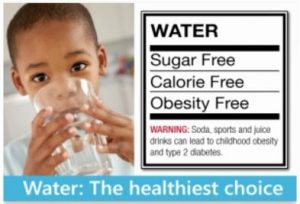
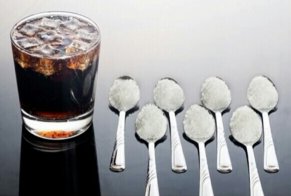
Step 2.
Remember, humans store glucose as glycogen. Plants store glucose as starch.
When we eat the plant starch we’re really eating glucose, because our digestion converts the plant starch back to glucose again.
We then use the glucose for energy, and for topping up our glycogen stores. And of course, if there’s any glucose left over, it’s converted to fat and stored where we don’t want it.
Choose carbohydrates like leafy vegetables and salads. They contain small amounts of starch, have a lot of fibre, vitamins, minerals, antioxidants, and other nutrients, and are slow to be digested into glucose.
In contrast, starchy carbohydrates (rice, pasta, noodles, bread, potatoes, refined grains, flours, baked goods, cereals) have very little or no fibre, hardly any natural nutrients, and lots of starch. They’re easily digested to heaps of glucose, which sky-rockets our blood sugar and insulin levels.
The excess glucose will be converted to triglycerides and stored in our liver (contributing to NAFLD), and deposited in the fat stores around our waist (contributing to metabolically active abdominal fat).
Step 3.
Eat a sensible amount of fruit, in order to keep as low as possible, the amount of fructose available for our livers to convert to fatty triglyceride.
Actually, we can get all the nutrients found in fruit, by eating a variety of leafy vegetables – with the added bonus of no big glucose and fructose hit.
Step 4.
Eat a moderate amount of protein for building and repair of tissues, but don’t eat lots of it. We can’t store protein, so protein in excess of our daily need is converted to triglyceride, too.
There’s more info about protein requirement in the post ‘How much protein do you need?‘
Step 5.
Add healthy fats (nuts, avocados, olives, olive oil, coconut oil, butter) to your meals to replace the calories from starchy foods.
Healthy fat makes the food taste better, and keeps you feeling satiated for much longer. And when you’re not hungry you’ll eat less and reduce your liver and abdominal fat.
Step 6.
Fast intermittently.
Fasting is the second effective way to turn on your fat-burning switch.
The thought of voluntarily going without food may be difficult to contemplate, but it need not be as unpleasant as you might imagine.
The easiest way to fast is to stop eating after 8pm at night, or some other time you designate.
Then either skip breakfast the next day, or have it mid-morning. If you manage to hang on until lunch-time before eating, even better.
Looking at the timing, you will have had nothing to eat between 8pm one evening and late breakfast at 10am the next day, which is no food for 14 hours.
In other words, you have fasted for 14 hours, but you didn’t notice most of it because you were sleeping. Think of it as a very short hibernation.
After about 10 hours your body will have used up the glycogen stored in your liver, so for approximately 4 hours your fat switch will have turned on and you will have been burning fat to make energy – and taking a step towards reversing fatty liver or reducing your apple shape.
Any change in habitual routines is difficult at first, but keep going and you’ll find it becomes easy to skip a meal.
And then when you do eat, enjoy a low carbohydrate, healthy fat (LCHF) meal that will keep you satisfied and energised for hours. Check out the websites in the sidebar on the right of this page for lots of meal ideas and recipes.
Further info
SugarScience
There’s a lot of new information about sugar on the aptly-named sugarscience.org website.
The contributions from a team of medical and research doctors are written so everyone can understand them – there’s no need to have a knowledge of science.
Dr Robert Lustig, the well-known professor of children’s medicine specialising in endocrinology at the University of California, San Francisco (UCSF), is one of the founders.
He sees first-hand the detrimental effects of added sugar on his young patients, and has been campaigning for a long time to make people aware of the dangers of sugar, and in particular, fructose.
Well worth having a look around the website, especially if you have children. Maybe start with this short article about sugar hiding in 74% of packaged foods.
SugarByHalf
A new website has been started by Professor Peter Bruckner and a group of like-minded people.
Quote: ‘We are a team of parents, health experts and communications professionals who understand the impacts of consuming too much sugar and how to navigate our sugar-saturated world.’
Professor Bruckner’s talk introducing the new not-for-profit organisation is fascinating: a real eye-opener. I’ve added it to Thrive Low Carb’s YouTube playlist – for the sake of your family’s health, please invest the time to watch it.
Documentary
Recently, daughter Kate posted us a present – the Australian documentary, ‘That Sugar Film‘, by actor Damon Gameau.
Damon shows where sugar lurks unexpectedly in foods recommended as healthy food choices, finds out what sugar from the ‘healthy’ foods does to his own body and liver, and asks why the detrimental health effects are being hidden from us.
Here’s a good written review of the film, and if you decide to buy it, you can get it on iTunes or from Amazon.
Infographic
Have a look at the clickable infographic on CNN’s website: ‘How much sugar is in that drink?‘
You’ll be amazed how much sugar there is in drinks children are given everyday, like apple juice.
And even in the alternatives many parents believe to be healthier, like soy milk, skimmed milk, and almond milk.
Video
In less than 14 minutes, Butter Bob Briggs explains in a way everyone can understand, how sugar damages our health.
Wish you success with reducing sugar in your life, and your loved ones’ lives. It’s not easy, but for the sake of your family’s health you have to persevere.
I’m sure you’ll agree with the American Heart Association that ‘Healthy Kids Are Sweet Enough’.
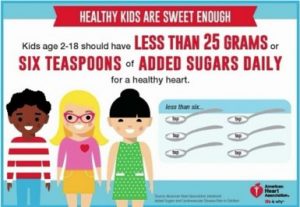
As always, if you’ve got a question, please get in touch via the comment box below, and I’ll do my best to help you.

